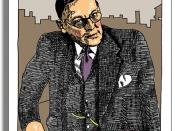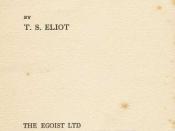About the time of World War I came a man that would help change the thinking of many people. T.S. Eliot, along with many other poets and artists, headed a new revolution known as Modernism. According to Lavender, (1998) modernism is a rebellion against the Victorian traditions of that time. Modernists believed that the industrialized nations with cash-based economies, primarily Protestant Christian, were not the "civilized" people. Instead, they saw them as greedy hypocrites who made freedom unattainable. The modernists thought that the truly civilized people were the people who Victorians considered savage: hunters/gatherer tribes with barter-based economies with mainly "pagan" beliefs. T.S. Eliot's poetic works helped him be considered by Gradesaver (n.d.) as the "the voice of Modernism" and one of the greatest poets of the 20th century.
Thomas Stearns Eliot was born on September 26, 1888, in St. Louis, Missouri, and was the youngest of seven children. His father, Henry Ware Eliot, was the president of the Hydraulic-Press Brick Company, and his mother, Charlotte Champe Stearns, was a former teacher and an amateur poet.
His grandfather, William Greenleaf Eliot, was the founder of the Unitarian church in St. Louis and was an important leader in St. Louis's religious and civic life. (Bush, 1999)
Eliot's primary education consisted of Ms. Locke's Primary School and Smith Academy, both in St. Louis. The year of his graduation from Smith Academy was the first time his poems and prose pieces appeared publicly in the Smith Academy Record. After graduating from Smith Academy, Eliot went to a prep school in Massachusetts before entering Harvard in 1906. At Harvard, he regularly wrote in the Harvard Advocate and studied under professors such as Paul Elmer More and Irving Babbit while studying the poetry of Dante that would later prove to be a major influence in...
![[Portrait of Teddy Kaye, Vivien Garry, and Arv(in) Charles Garrison, Dixon's, New York, N.Y., ca. May 1947] (LOC)](https://s.writework.com/uploads/14/145719/portrait-teddy-kaye-vivien-garry-and-arv-charles-garrison-d-thumb.jpg)

